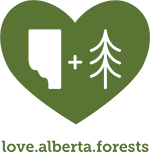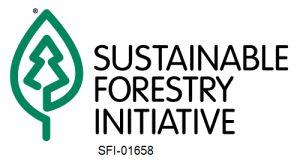Utilization, sustainability, site productivity, balancing of resource values and managing for a healthy forest are all concepts which have been combined to help define Spray Lake Sawmills’ management philosophy.
Forest management is a long term proposition. It takes years, decades and even centuries to fully appreciate the implications and rewards of management practices employed today. But, as noted by the company’s key value, “The Forest is our Future”; not only our future but our children’s future. Given this imperative we have designed our management systems accordingly. Optimal and wise use of fibre derived from our forests are focal to this philosophy.
The company employs a harvesting system known as stumpside processing. With this system the tree tops and limbs (otherwise referred to as slash) is left scattered throughout the cutovers. This provides a number of benefits compared to the old system of delimbing the trees at the side of the road. The cone bearing slash assists in our reforestation efforts by releasing seed to help augment stocking levels on top of our tree planting program. The slash catches and retains snow to assist in soil moisture conservation and provides sheltered micro-sites for the seedlings during their first few years of establishment. This system aides in maintaining long term site productivity by reducing soil compaction and recycling the nutrients as the slash decomposes. The slash also provides a further benefit of reducing or slowing down any surface flow of water which may result from spring run-off or after heavy rains. Finally, this has also eliminated the need for piling and burning slash accumulations at the side of the road. Of note, Spray Lake Sawmills has not conducted an ongoing pile burning program since 1998.
At the broader scale, cutblocks are designed to emulate patterns, sizes and shapes of naturally occurring disturbances such as fire. Block boundaries are made to align with stand boundaries and topographic features. Islands or patches of forest structure are left in a random pattern within the blocks and less economic species such aspen are retained on site in favour of the value they contribute to the areas wildlife and aesthetics.
As a package, these fibre management strategies play a large part in providing us with a healthy sustainable forest; one that not only provides some economic value but also recognizes other intrinsic values and uses of the forest. As a society, we have virtually eliminated fire from the natural cycle of forest renewal. These management strategies help replace “stand replacement fires” with a more managed type of disturbance and forest renewal.
Optimizing fibre use doesn’t end in the forest. Once in the yard every flake of bark and every speck of sawdust gets used and manufactured into a saleable product The company produces a range of lumber products, agricultural fence posts, wood chips for use in various pulp and paper products and a full line of reclamation and landscaping products. An old cyclone-burner can still be seen in the company’s yard but this is a relic from days of old. It hasn’t been fired up in over a dozen years. Further to the production of primary products the company provides further value added to the line-up through a treating plant and a fleet of blower trucks for delivery and placement of the reclamation and landscaping product lines. We are truly at the point of being able to claim 100% utilization.


